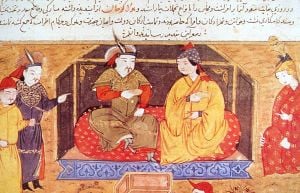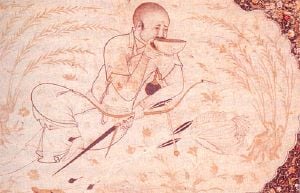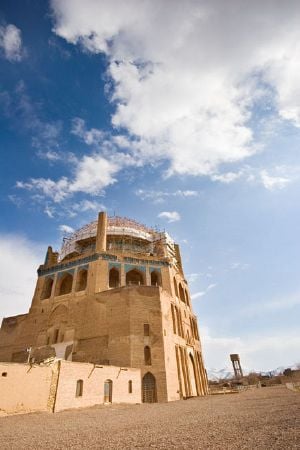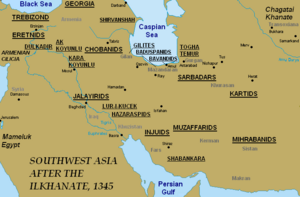Il-Khan dynasty
The Ilkhanate, also spelled Il-khanate or Il Khanate (Ch: 伊利汗国, Persian: سلسله ایلخانی), was one of the four khanates within the Mongol Empire. It was centered in Persia (Ch:波斯), including present-day Iran, Iraq, Afghanistan, Turkmenistan, Armenia, Azerbaijan, Georgia, Turkey, and western Pakistan. It was based, originally, on Genghis Khan's campaigns in the Khwarezmid Empire in 1219-1224, and the continual expansion of Mongol presence under the commands of Chormagan, Baiju, and Eljigidei.
Hulegu
After a battle against the Turks in 1243, the Mongols had occupied Anatolia, and the Sultanate of Rum became a vassal of what would later become the Ilkhanate Mongols.
The founder of the Ilkhanate dynasty was Hulegu Khan, grandson of Genghis Khan and brother of Mongke khan. Taking over from Baiju in 1255 or 1256, he had been charged with subduing the Muslim kingdoms to the west "as far as the borders of Egypt." This occupation led the Turkmens to move west to escape from the Mongolian tribes, which eventually gave birth to the Ottomans.
Hulegu then returned to the Persian heartland and established his dynasty. His expedition towards Egypt, however, was halted in Palestine in 1260 by a major defeat at the Battle of Ain Jalut at the hands of the Mamluks of Egypt.
Early il-Khanate

The term il-Khan means "subordinate khan" and refers to their initial deference to Mongke as great khan and ultimate sovereign of the entire empire. Hulegu's descendants ruled Persia for the next eighty years, beginning as shamanists, then Buddhists and ultimately converting to Islam. However, the Il-khans remained opposed to the Mamluks (who had defeated both Mongol invaders and crusaders), but were never able to gain significant ground against them, eventually being forced to give up their plans to conquer Syria, and their stranglehold over their vassals the Sultanate of Rum and the Armenian kingdom in Cilicia. This was due to the hostility of the khanates to the north and east—the Chagatai khanate in Mughulistan and the Blue Horde of Batu threatened the Il-khanate in the Caucasus and Transoxiana, preventing expansion westward. Even under Hülegü's reign, the Ilkhanate was engaged in open warfare in the Caucasus with the Mongols in the Russian steppes.
Franco-Mongol alliance
Many attempts towards the formation of a Franco-Mongol alliance were made between the courts of Western Europe and the Mongol Empire (primarily the Ilkhanate) in the 13th and 14th centuries, starting from around the time of the Seventh Crusade. United in their opposition to the Muslims (mainly the Mamluks), the Ilkhanate and the Franks (designating all western Europeans, but especially those associated with the Crusader States)[1] were only fleetingly and briefly successful at effective cooperation against their common enemy. The fundamental nature of the alliance doomed it from the start and the changing politics of the Middle East sealed its fate.[2]
Conversion to Islam
In the period after Hulegu, the il-khans increasingly adopted Tibetan Buddhism. Christian powers were encouraged by what appeared to be a favoring of Nestorian Christianity but this probably went no deeper than their traditional even handedness(Medieval Persia 1040-1797, David Morgan p64). Thus the Il-khans were markedly out of step with the Muslim majority they ruled. However, Ghazan, shortly before he overthrew Baidu, converted to Islam and his official favoring of Islam went along with a marked attempt to bring the regime closer to the non-Mongol majority. Christian and Jewish subjects however lost their equal status with Muslims and again had to pay the poll tax. Buddhists had the starker choice of conversion or expulsion.[3] In foreign relations however things this conversion had no effect and Ghazan fought the Mamluks for Syria. For the most part, this policy continued under his brother Öljeitü despite suggestions that he might seek to favor the Shiah brand of Islam. He succeeded in conquering Gilan on the Caspian coast and his magnificent tomb in Soltaniyeh remains the best known monument of Ilkhanid rule in Persia.
Disintegration
After Abu Sa'id's death in 1335, the khanate began to disintegrate rapidly, and split up into several rival successor states, most prominently the Jalayirids. The last of the obscure Il-khan pretenders was assassinated in 1353. Timur the Lame later carved a state from the Jalayirids, ostensibly to restore the old khanate.
The historian Rashid al-Din wrote a universal history for the khans around 1315 which provides much material for their history.
Il-Khanid Dynasty rulers
- Hülegü (1256-1265)
- Abaqa (1265-1282)
- Ahmad Tegüder (1282-1284)
- Arghun (1284-1291)
- Gaykhatu (1291-1295)
- Baydu (1295)
- Mahmud Ghazan (1295-1304)
- Muhammad Khodabandeh (Oljeitu) (1304-1316)
- Abu Sa'id Bahadur (1316-1335)
Post-Ilkhanate rulers
After the Ilkhanate, the regional states established during the disintegration of the Il-khanate raised their own candidates as claimants.
- Arpa Ke'ün (1335-1336)
- Musa (1336-1337) (puppet of 'Ali Padshah of Baghdad)
- Muhammad (1336-1338) (Jalayirid puppet)
- Sati Beg (1338-1339) (Chobanid puppet)
- Sulayman (1339-1343) (Chobanid puppet, recognized by the Sarbadars 1341-1343)
- Jahan Temur (1339-1340) (Jalayirid puppet)
- Anushirwan (1343-1356) (non-dynastic Chobanid puppet)
- Ghazan II (1356-1357) (known only from coinage)
Claimants from eastern Persia (Khurasan):
- Togha Temür (c. 1338-1353) (recognized by the Kartids 1338-1349; by the Jalayirids 1338-1339, 1340-1344; by the Sarbadars 1338-1341, 1344, 1353)
- Luqman (1353-1388) (son of Togha Temür)
See also
| History of Greater Iran |
|---|
| Empires of Persia · Kings of Persia |
| Pre-modern |
|
Before Islam |
|
After Islamic Conquest |
|
Modern
SSR = Soviet Socialist Republic
|
- Ilkhani
- Full list of Iranian Kingdoms
- Sarbadars, the famous political movement of the Il-Khanid era of Persia.
Notes
- ↑ Between the 11th to the 15th century, the Crusaders were usually called Franks. More broadly the term applied to any persons originating in Catholic western Europe (medieval Middle Eastern history). The term led to derived usage by other cultures, such as Farangi, firang, farang and barang. "The term [Frank] was used by all the populations of the eastern Mediterranean to designate the totality of the Crusaders as well as the settlers" Atlas des Croisades,1996, Jonathan Riley-Smith, ISBN 2862605530
- ↑ "Despite numerous envoys and the obvious logic of an alliance against mutual enemies, the papacy and the Crusaders never achieved the often-proposed alliance against Islam". Atwood, Encyclopedia of Mongolia and the Mongol Empire, p. 583, "Western Europe and the Mongol Empire"
- ↑ Medieval Persia 1040-1797, David Morgan p72
ReferencesISBN links support NWE through referral fees
- Atwood, Christopher P. (2004). The Encyclopedia of Mongolia and the Mongol Empire. Facts on File, Inc. ISBN 0-8160-4671-9.
- C.E. Bosworth, The New Islamic Dynasties, New York, 1996.
- R. Amitai-Preiss: Mongols and Mamluks: The Mamluk-Ilkhanid War 1260-1281. Cambridge, 1995
External links
- Ilkhanids Dynasty Mongolian dynasty
- Encyclopedia Iranica. Contains more information on the Il-Khanate.
- [1] Contains a searchable database for Ilkhanid coins
| Mongol Empire | ||||||
|---|---|---|---|---|---|---|
| Politics, organization and daily life | Military Campaigns | People | Terms | |||
Khanates
Notable cities |
Asia
|
Emperors and rulers
Prominent military generals
|
Titles
Political and military terms
| |||
ar:إلخانات az:Elxanilər Dövləti de:Ilchane es:Ilkanato fa:ایلخانیان fr:Houlagides it:Ilkhanato ms:Ilkhanat nl:Il-kanaat ja:イルハン朝 no:Ilkhanate pl:Ilchanidzi pt:Ilkhanato ru:Хулагуиды sr:Илканат fi:Il-kaanien valtakunta sv:Ilkhanatet tr:İlhanlılar zh:伊兒汗國
Credits
New World Encyclopedia writers and editors rewrote and completed the Wikipedia article in accordance with New World Encyclopedia standards. This article abides by terms of the Creative Commons CC-by-sa 3.0 License (CC-by-sa), which may be used and disseminated with proper attribution. Credit is due under the terms of this license that can reference both the New World Encyclopedia contributors and the selfless volunteer contributors of the Wikimedia Foundation. To cite this article click here for a list of acceptable citing formats.The history of earlier contributions by wikipedians is accessible to researchers here:
The history of this article since it was imported to New World Encyclopedia:
Note: Some restrictions may apply to use of individual images which are separately licensed.


